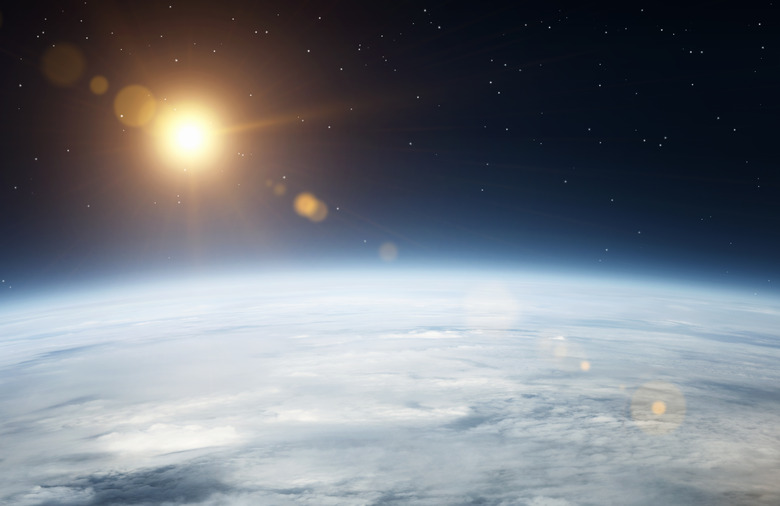Order Of The Planets By The Distance From The Sun
The solar system in which we live is home to eight planets including Earth. The number was reduced from nine when Pluto was reclassified as a dwarf planet in 2006. The distance of each planet from the sun is a determinant of its basic composition. Mars and the planets inside its orbit are known as terrestrial planets because they are composed mostly of rock. The ones outside its orbits are known as gas giants or, in the case of the two outermost planets, ice giants. The outer planets may have rocky cores, but if so, the cores are deeply embedded in the mixture of gas and ice that forms their bulk. One reason for Pluto's reclassification is that, orbiting beyond Neptune and yet being mostly rock, it doesn't conform to this pattern.
Mercury
Mercury
Mercury, named after a Roman god, is 36 million miles away from the sun and 48 million miles from Earth. It is the smallest planet in the solar system, with a diameter of 3,031 miles. It takes 87.96 Earth days for Mercury to revolve around the sun, faster than any other planet, and 58.7 Earth days to rotate on its axis. Mercury's surface is marked by smooth plains and deep craters, and the planet is made mostly of rock and metal.
Venus
Venus
Venus, named after the Roman goddess of love and beauty, is 67.2 million miles from the sun and 26 million miles away from Earth. It is the sixth largest planet in the solar system with a diameter of 7,521 miles. It takes 224.68 Earth days for Venus to revolve around the sun and 243 Earth days to rotate on its axis. Therefore, it is the planet with the longest day. Venus, the the brightest object in the sky besides our sun and the moon, has a surface with rocky and dusty mountains, canyons and plains.
Earth
Earth
The planet Earth is 93 million miles away from the sun, and with a diameter of 7,926 miles, it is the fifth largest planet in the solar system. As far as we know, it is the only planet with life, and about 70 percent of its surface is covered in water. Earth revolves around the sun once every 365 days and rotates on its axis in 24 hours. Earth is estimated to be more than 4.5 billion years old.
Mars
Mars
Mars is often referred to as the Red Planet, because it's covered with reddish dust and rocks. It is named after the Roman god of war and is 141.6 million miles away from the sun. Mars is the seventh largest planet in the solar system, with a diameter of 4,222 miles. It takes 686.98 Earth days for Mars to revolve around the sun, and it rotates on its axis in 24.6 Earth hours. It has a hard, dry, rocky surface and two moons.
Jupiter
Jupiter
Jupiter, the largest planet in the solar system, is 483.8 million miles away from the sun. It has a diameter of 88,729 miles, which means that you can fit all the other planets inside it and over a dozen Earths can line up across it. It takes Jupiter 11.862 Earth years to revolve around the sun and 9.84 Earth hours to rotate on its axis, making it the planet with the shortest day. Jupiter has at least 63 moons and is mostly made of hydrogen and helium.
Saturn
Saturn
Saturn, best known for its rings made of billions of ice particles, is 886.7 million miles away from the sun and 550.9 million miles from Earth. It has a diameter of 74,600 miles, making it the second largest planet in the solar system. It takes 29.456 Earth years for Saturn to revolve around the sun and 10.2 Earth hours to rotate on its axis. Saturn is made of liquid and gas, so it would actually float on water.
Uranus
Uranus
Uranus, the first planet discovered with a telescope, is 1,784.0 million miles away from the sun. It is named after the Greek god of the sky and has a diameter of 32,600 miles, making it the third largest planet in the solar system. It takes 84.07 Earth years for Uranus to revolve around the sun and 17.9 Earth hours to rotate on its axis. Uranus is made of hydrogen, helium and methane and has no solid surface.
Neptune
Neptune
The farthest planet from the sun at 2,794.4 million miles away is Neptune, named after the Roman god of the Sea. It has a diameter of 30,200 miles and is the fourth largest planet in the solar system. It takes 164.81 Earth years for Neptune to revolve around the sun and 19.1 Earth hours to rotate on its axis. Like Uranus, Neptune is made of hydrogen, helium and methane.
Cite This Article
MLA
Romualdez, Veronica. "Order Of The Planets By The Distance From The Sun" sciencing.com, https://www.sciencing.com/order-planets-distance-sun-8371065/. 22 June 2018.
APA
Romualdez, Veronica. (2018, June 22). Order Of The Planets By The Distance From The Sun. sciencing.com. Retrieved from https://www.sciencing.com/order-planets-distance-sun-8371065/
Chicago
Romualdez, Veronica. Order Of The Planets By The Distance From The Sun last modified March 24, 2022. https://www.sciencing.com/order-planets-distance-sun-8371065/
